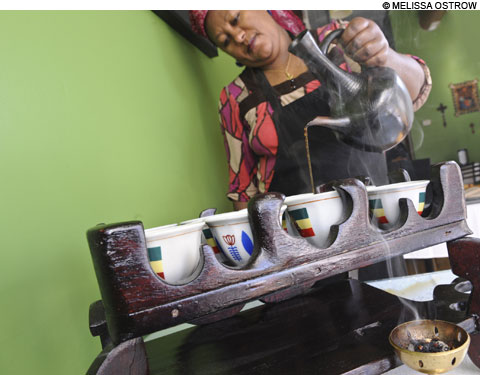
THE COFFEE CEREMONY at Blue Nile, like much of the menu here, presents some of the best in Ethiopian cuisine and culture. |
Either this is the best Ethiopian food in Boston, or the whole scene has advanced greatly since the last time I got to review in this genre. The immediate change for me in this 10-table storefront is real teff injera. If readers are new to this cuisine, injera are the sourdough pancakes that serve as an all-purpose utensil in Ethiopian food. You tear off a little piece of pancake with your right hand, and pick up some food and thus eat with your hand, neatly. Or it would be neatly, if you grew up with it. For me, it requires a bigger piece and multiple tries, and the injera under the food soaks up the sauce and gets really good, so I'm not going to leave any of that on the plate, and so soon enough, with the wheat- or barley-based injera hitherto available in Boston's Ethiopian and Eritrean restaurants . . . it feels like I have swallowed a lead basketball.Teff is the tiniest grain to be used as a staple food, with grains about the size of granulated sugar, and rich in fiber and minerals. It lends a certain flavor and darker color to injera, but the really great thing about teff injera is that it isn't as starchy, so when a non-Ethiopian eats Ethiopian food inefficiently, requiring more injera per bite, the teff injera doesn't expand in one's stomach like a lead basketball.
Another major improvement is the sauces. The first wave of Ethiopian restaurants had only one sauce: berbere, a kind of secret-recipe season-all that combines the intensity of curry powder, chili powder, Cajun seasoning, and enriched uranium. (No, I'm joking about the Cajun seasoning.) Blue Nile, however, has several different sauces, a good variety of vegetarian options — Ethiopian Coptic Christians have many, many partial fast days — and a certain freshness to the flavors that I had been missing.
This is evident from the opening "azefa" ($4.50), a lentil salad with a lively acidity, and the quick, transient spice of sliced-in jalapeño peppers. This salad was also my first shot with the teff injera, and our party managed not to use every bit. An appetizer of spiced cottage cheese ($3.99) lightened it up with chopped collard greens and arranged the chili hit for the aftertaste. "Timatim fitfit" ($3.95) is another salad, this time based on tomatoes, and very good ones for the time of year. Anytime I see the word "fitfit" I get worried, because this implies leftover injera used to thicken a stew or salad. But this salad is like panzanella with plenty of lemon and chopped onion, and a milder jalapeño jab here and there.
Fried apps are not to be missed. Sambosa ($3.50) is the far-west version of this trans–Indian Ocean fried triangle, likely diffused to East Africa by Malay traders. In a small room, these come right out, hot and crisp, not greasy, with a spinach-onion filling that is much lighter than Indian or Malaysian samosas or Middle East sambuseks. The lentil version is only a little stodgier.